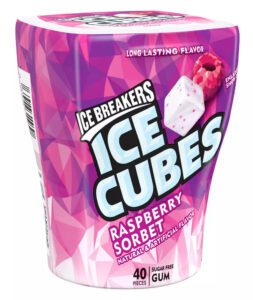You’re picking up the bag you left by the front door only to discover that the tub of sugar-free gum you keep in your bag is laying on the floor, emptied of its contents. Your dog is sitting nearby with conspicuously minty breath. A flood of panic comes over you – and it should, because if that sugar-free gum contains xylitol, your dog may be at risk of dying from xylitol toxicity.
The symptoms of xylitol poisoning can start within 20 minutes. Signs include:
- Vomiting
- Decreased activity level
- Weakness and collapse
- Difficulty walking or standing
- Shaking or seizures
- Coma
- Liver failure
- Bleeding problems
Xylitol is a sugar substitute known as a sugar alcohol. It can be found in many different household items toxic to dogs. Including sugar-free gums and mints, adult and children’s chewable vitamins and supplements, baked goods, mouthwash and toothpaste, cough syrup and other liquid medications, and even some brands of peanut butter.
How xylitol affects dogs
Xylitol stimulates a dog’s pancreas to produce large quantities of insulin. Insulin is the hormone that allows glucose (sugar) to be taken up from the bloodstream and into the body’s cells. A sudden large influx of insulin causes so much glucose to be taken up by the cells in a dog’s body that his blood glucose drops to dangerously low levels. This is known as hypoglycemia.
Hypoglycemia from xylitol ingestion can occur quickly, often within the first 10 to 15 minutes of ingestion. Low blood sugar can cause ataxia (wobbly gait), vomiting, tremors, weakness, and seizures. Untreated xylitol ingestion can progress to coma and death.
Xylitol can also cause liver damage when ingested in high quantities. Dogs with xylitol-related liver damage may develop difficulty clotting. This can cause bruising and internal bleeding.
Treatment for Xylitol Poisoning
If your dog has ingested xylitol, your veterinarian will recommend that your dog be hospitalized on intravenous fluids. He will need to receive intravenous dextrose (a form of sugar) and have his blood glucose levels monitored every two to four hours. Dogs who have ingested xylitol are typically hospitalized for 24 to 48 hours until they are able to maintain a normal blood glucose without dextrose supplementation.
Dogs who develop xylitol-induced liver damage require more intensive care. They often require one or more transfusions of fresh frozen plasma – a blood product that contains proteins and clotting factors but not red blood cells – to replace the clotting factors their livers are not able to produce. They also are given medications to help support and protect their livers from further damage. Dogs with xylitol-induced liver damage are typically hospitalized for three to five days and sometimes longer, depending on their response to treatment.
If your veterinarian is not able to provide round-the-clock care for your dog, she may recommend that your dog be transferred to an emergency and critical care hospital. Upon transfer, your dog will be hospitalized in an intensive care unit in order to receive continuous monitoring and dedicated nursing care.
Dogs who receive quick intervention and appropriate treatment for xylitol ingestion have a good chance of a fast recovery. Dogs who develop xylitol-induced liver damage will have a prolonged recovery that may require medications and follow-up bloodwork for a month or more following discharge from the hospital.
You just found an empty tub of sugar-free gum on the floor. Don’t panic! And follow these steps to ensure the best for your dog’s health and safety:
- Look at the ingredient list on the label. If xylitol is listed, proceed to step 2. Otherwise, breathe a sigh of relief and hug your dog.
- Do not induce vomiting at home with hydrogen peroxide unless directed to do so by a veterinarian. Hydrogen peroxide has been shown to cause inflammation of the esophagus and stomach ulcers in dogs. Your veterinarian can induce vomiting with a much safer and more effective drug.
- Call ASPCA Poison Control at (888) 426-4435 and take your dog to your veterinarian or the nearest emergency hospital immediately.
- Upon arrival at the veterinary hospital, tell the staff what and how much your dog ingested, the poison control case number you have been provided by ASPCA Poison Control, and any medications your dog is taking or medical conditions he has.
- Your veterinarian will induce vomiting to recover as much of the gum as possible. On average, only about 60% of ingested product is recovered from vomiting.
- Your veterinarian will contact a toxicologist at ASPCA Poison Control using the case number you provided and formulate a treatment plan specifically for your dog.
We know that xylitol is toxic to dogs. So why do I need to contact poison control if my dog has ingested a product containing xylitol?
Although xylitol may be in a product’s ingredient list, the amount of xylitol is not specifically listed on the label. You may notice an entry for “sugar alcohol” on the nutrition label. Most products that contain xylitol also contain other sugar alcohols, like maltitol and sorbitol. These are not toxic to dogs but are included in the total gram count of sugar alcohols on the label. This means that we cannot rely on the amount of sugar alcohol on the label to tell us how much xylitol a product contains.
The amount of xylitol a product contains can vary by flavor. For example, the popular sugar-free gum Ice Breakers has a wide variety of flavors. Each gum flavor contains a different amount of xylitol. Therefore, a dog who ingested strawberry daiquiri flavored Ice Breakers may have received a different dose of xylitol than a dog who ingested the grape flavored Ice Breakers.

ASPCA Poison Control maintains an extensive database of potentially toxic products and the amount of toxin each product contains. This organization is staffed by veterinary toxicologists, veterinarians, and licensed veterinary technicians that have been trained in toxicology. The information and advice they provide is constantly being updated based on the latest science, toxic product information, and medical knowledge about our pets.
When you and your veterinarian consult with ASPCA Poison Control, they formulate a customized treatment plan tailored to your dog and the toxin he ingested. Your veterinarian will also be able to follow-up with an ASPCA toxicologist during the course of your dog’s treatment. There is an initial consultation fee charged by ASPCA Poison Control that covers creating your dog’s customized treatment plan and any adjustments to that plan.
The level of treatment intervention may vary depending on how much your dog weighs, how much xylitol he ingested, any medications your dog receives, and your dog’s current health condition. The amount of xylitol-containing product recovered from making your dog vomit, how long it has been since your dog ate the product, and whether or not your dog is already showing symptoms of xylitol ingestion will also influence the treatment plan.
If the amount of xylitol your dog ingested is within a certain range, then your dog may only require monitoring and treatment for hypoglycemia. But if your dog ingested an amount that is known to potentially cause liver damage or failure, then it may be recommended to begin interventions to protect your dog’s liver before the damage or failure becomes clinically apparent.
Contacting ASPCA Poison Control when your dog has ingested a xylitol-containing product is one of the best things you can do to help your dog!







Good morning,
This is a very good article. It certainly sent me scurrying to the packages of various items, especially peanut butter, toothpaste and sugar free gum that we have here in the house. I am writing from Canada. I was wondering if the xylitol added to these items could be for items sold mainly in the USA, as there did not seem to be any of the brands listed that are sold here in Manitoba, at least. Thanks for the heads up, hpwever. I will most certainly continue to check lables very carefully to make certain that no item that our dog enjoys “licking the package” ( especially ice cream) contains this ingredient. Sincerely, Margaret Smith, St. Andrews, MB, Canada